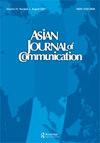从英汉翻译看新闻框架
IF 1.5
2区 文学
Q2 COMMUNICATION
引用次数: 0
摘要
快递服务,以及十亿美元的菲律宾移民产业(第22页)。因此,从更广泛的意义上讲,“(非)移动家庭”视角提供了一个有利位置,可以将跨国家庭置于新自由主义全球经济中现有的不平等中。卡巴尔昆托的作品为理解流动性的政治提供了一个很好的例子(Cresswell, 2006;Urry, 2007)在跨国家庭生活的背景下。除了书中所呈现的丰富而充满情感的故事之外,这本书通过阐明它们的偶然后果(第186页,第8章),强调了移动性和不移动性的概念纠缠。与“廉价电话”时代相比,使用今天的移动设备和平台可以更容易地实现“中介/通信移动性”,这是肯定的。然而,这些新形式的“社会粘合剂”也有助于从微观到宏观层面固定个人在跨国家庭生活中的处境,从个人获得社会技术资源到他们在更广泛的跨国社会网络中的社会结构地位。从这个意义上说,这本书与理解技术的社会塑造传统(MacKenzie & Wajcman, 1999)是一致的,后者拒绝了一种强烈的技术决定论立场,并强调了技术参与和技术消费的特定社会文化背景的共同构成。尽管特别关注菲律宾的背景,这本书当然吸引更广泛的关注移民,跨国家庭和数字媒体的交集的观众。鉴于2019冠状病毒病危机带来的动荡和不确定性,本书中的“(非)流动房屋”概念对那些长期家庭分离的人特别有意义,因为在这个(非)流动的大流行后时代,任何人都可以成为跨国/跨地区的家庭成员。本文章由计算机程序翻译,如有差异,请以英文原文为准。
News framing through English-Chinese translation
courier services, and the billion-dollar industry of Philippine migration (p. 22). The ‘(im)mobile home’ lens, therefore, provides a vantage point to situate transnational family in the existing inequality of a neoliberal global economy from a broader sense. Cabalquinto’s work offers a good example of understanding the politics of (im)mobilities (Cresswell, 2006; Urry, 2007) in the context of transnational family life. Beyond the rich and emotionally laden stories presented in the book, this book foregrounds the conceptual entanglement of mobility and immobility through elucidating their contingent consequences (p. 186, Chapter 8). It is certainly true that ‘mediated/communicative mobility’ can be achieved more easily by the use of today’s mobile devices and platforms when compared to the ‘cheap calls’ era. Yet, these new forms of ‘social glue’ also contributes to immobilizing individuals’ situations in their transnational family lives from micro to macro levels, ranging from personal access to socio-technical resources to their socio-structural positionality in broader transnational social network. In this sense, this book concurs with the social shaping tradition of understanding technology (MacKenzie & Wajcman, 1999), which rejects a strong techno-determinist stance and highlights the co-constitution of technological engagement and the specific social-cultural contexts where the technology is consumed. Despite the specific focus on the Filipino context, this book certainly appeals to wider audiences concerned with the intersection of migration, transnational families, and digital media. Given the turbulence and uncertainties produced by Covid-19 crisis, the notion ‘(im)mobile home’ in this book is of particular relevance for those who are plagued by long-term familial separation, since anyone can become a transnational/translocal family member in this (im)mobile post-pandemic era.
求助全文
通过发布文献求助,成功后即可免费获取论文全文。
去求助
来源期刊

Asian Journal of Communication
COMMUNICATION-
CiteScore
3.70
自引率
0.00%
发文量
38
期刊介绍:
Launched in 1990, Asian Journal of Communication (AJC) is a refereed international publication that provides a venue for high-quality communication scholarship with an Asian focus and perspectives from the region. We aim to highlight research on the systems and processes of communication in the Asia-Pacific region and among Asian communities around the world to a wide international audience. It publishes articles that report empirical studies, develop communication theory, and enhance research methodology. AJC is accepted by and listed in the Social Science Citation Index (SSCI) published by Clarivate Analytics. The journal is housed editorially at the Wee Kim Wee School of Communication and Information at Nanyang Technological University in Singapore, jointly with the Asian Media Information and Communication Centre (AMIC).
 求助内容:
求助内容: 应助结果提醒方式:
应助结果提醒方式:


